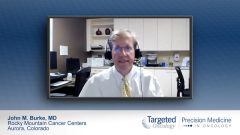
DLBCL: Prognosis and Goals of Therapy
Variables that impact a patient with diffuse large B-cell lymphoma, and prognosis and strategies for counseling patients on goals of therapy.
Episodes in this series

Marin F. Xavier, MD: For some patients here, [I’d like to get your] your sense about typical response rates. A third category is relapses and monitoring therapy in the post-frontline setting. I think of this disease as binary: either you’re cured or you’re not. If you’re not, in the past that meant there’s 20% who could be salvaged with autologous stem cell transplant; the rest will die. Now we’re in this new era. We have other therapies that are effective. I always go by that same thing. In the old days, if you lump everybody together—high risk, ultra triple hits, and regular—then you would say 60% can be cured and up to 80% salvage can be cured. The total is 80%, and 20% will die from a refractory disease up front. I don’t think I’ll change that in clinical practice. I feel we’re a little smarter about the biology, so I don’t think you can lump everybody together anymore. We know more prognostic information than we did 20 years ago.
John M. Burke, MD: Yeah.
Marin F. Xavier, MD: What’s your anecdotal clinical experience? What’s your percentage of cure? What do you tell patients when you’re laying the timeline for them or their pathway?
John M. Burke, MD: It’s high. The number that I tell everyone when they walk in the door is that we cure about 60% of folks with large cell lymphoma. A lot of times when I’m asked that question—“Doctor, what’s my prognosis?”—I don’t have all the detail you’ve described. You still don’t have the FISH [fluorescence in situ hybridization] back. You probably haven’t gotten the PET [positron emission tomography] scan yet. You’ve got a biopsy, and you’re seeing the patient within 48 hours, so you haven’t done the PET scan. So you’re forced to answer the question before you really have all the details. I provide that general number and then narrow it down once I know a little more about them—their stage. I still use the good old-fashioned IPI [International Prognostic Index] or the revised IPI. I pull out my iPhone, plug in the numbers, and tell them what it says based on that. They don’t fit the model, but cell of origin impacts things a little. The double hit certainly impacts things and can change how you have that prognosis conversation.
Marin F. Xavier, MD: It’s nice to hear because for the lady I saw yesterday, I couldn’t calculate her prognostic score. I didn’t even have her LDH [lactate dehydrogenase] or anything.
John M. Burke, MD: Yeah. But you got asked the question.
Marin F. Xavier, MD: Yeah. For that lady, they thought she had relapsed gynecologic cancer. We biopsied it, and it was large cell [lymphoma]. She was already teed up. That’s better than metastatic endometrial cancer. This can be cured. It was already curable, so the intention of therapy is cure. That’s where I go in with my doctor-patient relationship. I said the intention is to cure you. That’s what’s fun and that’s why I’m a lymphoma doctor. I hope we can do that.
Transcript edited for clarity.







































